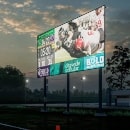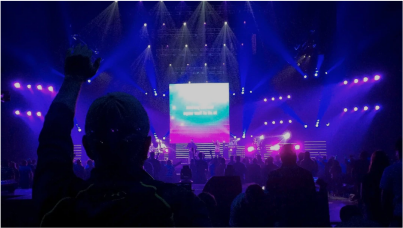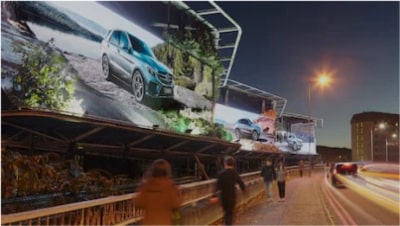What is Digital Out-of-Home (DOOH) Advertising? How Effective is it?
In a world where consumers are bombarded with advertisements at every turn, it's crucial for businesses to stand out from the noise and capture their audience's attention. Enter Digital Out-of-Home (DOOH) advertising – a powerful medium that combines the impact of traditional out-of-home advertising with the flexibility and interactivity of digital technology. This ultimate guide to DOOH advertising will not only shed light on its many facets but also reveal how it can revolutionize your advertising strategy and give your business a competitive edge.
Imagine captivating visuals, precise audience targeting, and real-time updates – all working in harmony to create memorable and engaging ads in high-traffic areas, from bustling city streets to sprawling shopping malls. As you dive into this comprehensive guide, you'll discover the various types of DOOH advertising, its numerous benefits, common formats, and use cases. Moreover, you'll learn about the factors that affect its effectiveness, how to measure success, and much more. So, buckle up and get ready to explore the dynamic world of DOOH advertising, where innovation meets impact.
What Is Digital Out of Home (DOOH) Advertising?
Digital Out-of-Home (DOOH) advertising is a dynamic, innovative way for businesses to communicate with their target audience using digital displays in public spaces. Unlike traditional Out-of-Home (OOH) advertising, which relies on static print materials, DOOH advertising incorporates digital technology, such as LED screens and digital billboards, to deliver dynamic, engaging content that captures the attention of consumers on the go. In today's fast-paced world, DOOH advertising has become an essential tool for businesses looking to stand out from the competition and make a lasting impression on their target audience.
Is DOOH an Effective Advertising Medium?
The simple answer is yes. DOOH advertising is an incredibly effective medium for reaching and engaging consumers. According to a study by Nielsen, OOH advertising can reach over 60% of a market's total population, and that may apply to DOOH advertising as well. Additionally, consumers tend to remember DOOH advertising more than traditional advertising forms, as the dynamic, eye-catching nature of digital content leaves a lasting impression on viewers.
What Are the Different Types of DOOH Advertising?
1. Static DOOH Advertising
Static DOOH advertising refers to digital ads that display a single image or message for a predetermined period. These ads don't incorporate video or animation, but they still provide a visually appealing and cost-effective way for businesses to reach their target audience.
2. Video DOOH Advertising
Video DOOH advertising uses moving images or animations to create a dynamic, engaging experience for viewers. This type of advertising is especially effective at capturing consumers' attention and keeping them engaged for longer periods than static ads.
3. Interactive DOOH Advertising
Interactive DOOH advertising takes engagement a step further by incorporating interactive elements, such as touch screens or augmented reality, that allow consumers to engage directly with the ad. This level of interactivity can lead to increased brand recall, longer dwell times, and a more memorable experience for the viewer.
What Are the Benefits of Digital Out of Home Advertising?
1. Increased Reach
Digital OOH advertising can help businesses reach a wider audience by placing their ads in high-traffic areas, such as airports, shopping centers, and sports arenas. This increased exposure allows businesses to connect with consumers they might not reach through traditional advertising channels.
2. Targeted Advertising
With digital OOH, businesses can deliver targeted advertising to specific audiences based on factors such as location, time of day, and demographics. This level of targeting allows for more effective ad campaigns that reach the right people at the right time.
3. Cost-effective
Compared to other forms of advertising, digital OOH can be more cost-effective because it allows businesses to reach a larger audience with a single ad placement. This can result in a lower cost per impression (CPI) and a higher return on investment (ROI) for advertisers.
4. Increased Engagement
Digital OOH can increase engagement by incorporating dynamic visuals and interactive features that capture consumers' attention and encourage them to interact with the ad. This increased engagement can lead to higher brand recall and a more memorable advertising experience.
5. Measurable Results
Digital OOH can provide businesses with measurable results, such as the number of views, engagement rates, and conversion rates, which can help them track the success of their campaigns. This data-driven approach allows businesses to make informed decisions about their advertising strategies and optimize their campaigns for maximum impact.
6. Flexibility
Digital OOH offers businesses the flexibility to update their ads in real-time and customize them based on the audience and location. This flexibility allows advertisers to respond to changing market conditions and deliver the most relevant messaging to their target audience.
7. Increased Foot Traffic
Digital OOH can help businesses increase foot traffic to their physical locations by promoting their products or services in high-traffic areas. By strategically placing digital ads near brick-and-mortar stores, businesses can drive more consumers to visit their locations and make a purchase.
8. Memorable Impression
Digital OOH can create a memorable impression on consumers by using dynamic visuals, interactive features, and engaging content. This memorable experience can lead to increased brand recall and a stronger connection between the consumer and the brand.
9. Real-time Data
Digital OOH can provide businesses with real-time data on their campaigns, which can help them optimize their messaging and targeting. This access to real-time data enables advertisers to make more informed decisions about their campaigns and adjust their strategies as needed.
10. Reduced Environmental Impact
Digital OOH can reduce the environmental impact of advertising by eliminating the need for print materials and reducing waste. By transitioning from traditional print materials to digital displays, businesses can minimize their carbon footprint and contribute to a more sustainable advertising landscape.
11. Innovation
Digital OOH offers businesses the opportunity to experiment with new technologies and creative approaches to advertising, which can lead to innovative campaigns that capture consumers' attention. This willingness to embrace new technologies and think outside the box can set businesses apart from their competitors and create a lasting impression on consumers.
12. Competitive Advantage
Digital OOH can give businesses a competitive advantage by providing a unique and innovative way to reach their target audience and stand out from the competition. By incorporating digital OOH advertising into their marketing mix, businesses can differentiate themselves from their competitors and establish a stronger presence in the marketplace.
What Are Common DOOH Advertising Formats?
1. LED Video Walls
LED video walls are one of the most popular formats of digital out-of-home (DOOH) advertising. They consist of a large number of LED panels arranged in a grid to form a video display. LED video walls are commonly used in high-traffic areas, such as shopping malls, airports, and sports stadiums, to deliver dynamic and engaging content.
2. Digital Billboards
Digital billboards are another common format of DOOH advertising. They are large, high-resolution displays that can be updated in real-time to deliver targeted messaging to specific audiences. Digital billboards are commonly used in urban areas and along highways to promote products, services, and events.
3. Digital Street Furniture
Digital street furniture refers to any type of outdoor furniture, such as bus shelters, kiosks, and benches, that has been outfitted with digital displays. Digital street furniture can be used to deliver targeted messaging to specific audiences in high-traffic areas.
4. Transit Advertising
Transit advertising involves placing digital displays on public transportation vehicles, such as buses, trains, and subways. Transit advertising can be used to deliver targeted messaging to specific audiences during their commute.
5. In-store Digital Signage
In-store digital signage is used to promote products and services inside retail stores. They can be used to display product information, promotions, and advertising messages to shoppers while they browse.
6. Point-of-sale Digital Displays
Point-of-sale digital displays are used to promote products and services at the point of purchase. They can be used to display product information, promotions, and advertising messages to shoppers while they wait in line to make a purchase.
7. Digital Cinema Advertising
Digital cinema advertising is used to promote products and services in movie theaters. They can be used to display advertising messages before the feature presentation, during intermission, and after the movie ends.
8. Stadium Advertising
Stadium advertising involves placing digital displays in sports stadiums and arenas. They can be used to display advertising messages, promote products and services, and engage with sports fans during games and events.
9. Airport Advertising
Airport advertising involves placing digital displays in airports to promote products and services to travelers.
They can be used to display advertising messages, provide flight information, and engage with travelers during their wait.
10. Interactive Displays
Interactive displays are digital displays that allow consumers to engage with advertising content in a more meaningful way. They can be used to deliver interactive games, quizzes, and surveys that capture consumer attention and increase engagement.
What Are Common Use Cases of DOOH Advertising?
1. Branding
DOOH advertising can be used to build brand awareness and reinforce brand identity by delivering targeted messaging to a wide audience.
2. Product Launches
DOOH advertising can be used to promote new products and services to a targeted audience in high-traffic areas, such as shopping malls, airports, and sports stadiums.
3. Promotions and Offers
DOOH advertising can be used to promote discounts, offers, and other special promotions to incentivize consumers to make a purchase.
4. Event Promotion
DOOH advertising can be used to promote upcoming events, such as concerts, festivals, and sporting events, to a targeted audience in relevant locations.
5. Public Service Announcements
DOOH advertising can be used to deliver public service announcements and other important messages to a wide audience.
6. Tourism and Travel
DOOH advertising can be used to promote tourist destinations and travel packages to a targeted audience in airports, train stations, and other transportation hubs.
7. Retail Marketing
DOOH advertising can be used to promote products and services in retail environments, such as shopping malls, department stores, and supermarkets.
8. Real Estate Marketing
DOOH advertising can be used to promote real estate properties to a targeted audience in relevant locations, such as high-traffic urban areas.
9. Corporate Communication
DOOH advertising can be used to communicate corporate messages and initiatives to employees and stakeholders in corporate environments, such as office buildings and conference centers.
10. Education and Awareness
DOOH advertising can be used to deliver educational and awareness messages, such as health and safety information, to a wide audience in relevant locations.
What Factors Affect DOOH Advertising Effectiveness?
1. Location
The location of a digital display can significantly impact the effectiveness of a DOOH advertising campaign. Strategically placing displays in high-traffic areas where the target audience is more likely to see them can increase the reach and impact of the advertisement.
2. Content Relevance
The relevance of the content to the target audience is crucial for the success of a DOOH advertising campaign. Advertisements that are tailored to the interests and needs of the audience are more likely to resonate with viewers and drive engagement.
3. Creative Quality
The quality of the creative assets used in a DOOH advertising campaign can impact its effectiveness. High-quality visuals, engaging content, and innovative designs can capture consumers' attention and create a memorable impression.
4. Display Quality
The quality of the digital display itself can affect the success of a DOOH advertising campaign. High-resolution displays with bright colors and clear images can enhance the visual impact of the advertisement and make it more appealing to viewers.
5. Target Audience
Understanding the target audience and their preferences is essential for creating a successful DOOH advertising campaign. Advertisers should tailor their messaging and creative assets to the specific demographics and interests of their target audience to maximize the effectiveness of the campaign.
How to Measure Success of Digital Out Of Home Media
To evaluate the success of a digital out-of-home media campaign, advertisers can use various metrics, such as:
- Reach: The total number of people who were exposed to the advertisement during the campaign.
- Impressions: The number of times the advertisement was displayed on the digital screens.
- Engagement: The level of interaction between consumers and the advertisement, which can be measured through metrics such as click-through rates, dwell times, or interactions with interactive features.
- 4. Conversion Rate: The percentage of consumers who took the desired action after being exposed to the advertisement, such as making a purchase or signing up for a newsletter.
- Return on Investment (ROI): The revenue generated by the advertising campaign, divided by the total cost of the campaign. A higher ROI indicates a more successful campaign.
- Brand Lift: The increase in brand awareness, brand perception, or brand preference as a result of the advertising campaign.
- Foot Traffic: The increase in the number of people visiting a physical location, such as a store or event, as a result of the DOOH advertising campaign.
Frequently Asked Questions
How is DOOH advertising different from traditional OOH advertising?
DOOH advertising utilizes digital displays, allowing for real-time updates, targeted messaging, and interactivity. Traditional OOH advertising relies on static print materials, like billboards and posters, which do not offer the same level of flexibility and engagement.
How effective is DOOH Advertising compared to other types of advertising?
DOOH advertising can be highly effective due to its ability to reach a wide audience, target specific demographics, and provide engaging, interactive experiences. However, its effectiveness depends on factors such as location, content relevance, and display quality.
How can DOOH Advertising be targeted to specific audiences?
DOOH advertising can be targeted by factors such as location, time of day, demographics, and consumer behavior. For example, an advertiser can choose to display ads only in specific neighborhoods or during certain times to reach their desired audience.
What role does technology play in DOOH Advertising?
Technology plays a crucial role in DOOH advertising, enabling the use of digital displays, real-time updates, and data-driven targeting. Innovations in technology also allow for interactive features and creative approaches that can enhance the impact of advertising campaigns.
What factors should be considered when choosing an LED video wall for DOOH Advertising?
When choosing an LED video wall, consider factors such as display size, resolution, brightness, durability, and energy efficiency. Additionally, think about the installation and maintenance requirements, as well as the overall cost of ownership.
What factors should be considered when choosing a Digital Billboard for DOOH Advertising?
When selecting a digital billboard, consider factors such as display size, resolution, brightness, durability, and energy efficiency. Location is also crucial, as you'll want to place the billboard in an area with high visibility and traffic.
Ultravision LED Solutions: Turnkey DOOH Advertising Solutions
As a leading provider of LED video walls and digital billboards for digital OOH advertising, Ultravision LED Solutions is dedicated to delivering turnkey advertising solutions that help businesses succeed in today's competitive market. Our innovative products and expert support make it easy for businesses of all sizes to implement effective, eye-catching DOOH advertising campaigns.
At Ultravision LED Solutions, we understand the importance of staying ahead of the curve when it comes to advertising technology. That's why we offer state-of-the-art LED displays that deliver stunning visuals, high resolution, and unparalleled energy efficiency. Our LED video walls and digital billboards are built to last, with durable components and a robust design that can withstand harsh weather conditions.
But we don't stop at providing the hardware. Our team of experts is here to help you every step of the way, from planning and installation to ongoing support and maintenance. We'll work with you to develop a custom DOOH advertising strategy that aligns with your goals, target audience, and budget.
Discover the powerful impact that DOOH advertising can have on your business with Ultravision LED Solutions. Visit the following page to explore our range of products and services, and take the first step towards transforming your advertising strategy for the digital age: https://ultravisionledsolutions.com/collections/main









